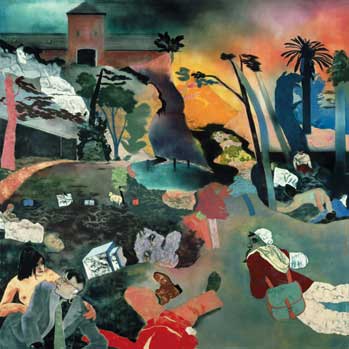The Waste Land
The Waste Land
By T. S. Eliot, with illustrations from the painting "If Not, Not" by R. B. Kitaj, an essay on the poem by Helen Vendler, and an essay on the painting by Marco Livingstone, 2007. $2,000.00
Publication 79
ADD TO CARTHelen Vendler writes that The Waste Land “reached so far beyond its origins in both life and literature that it revolutionized modern verse”. This long poem, published in 1922, was immediately recognized as a masterpiece, and it remains an icon of English literature. T. S. Eliot (1888-1965), born in St. Louis, Missouri, settled in London in 1914, became a British citizen in 1927, and remained in England the rest of his life. By mid-century Eliot was regarded on both sides of the Atlantic as the greatest living poet and The Waste Land as the most important contemporary poem. Since his death and the emergence of other major poets, reverence for Eliot has shifted to respect, but the poem is still seen as a signal work of art and continues to challenge readers with its complexity, reward with its brilliance, and surprise by its freshness.
This is the first illustrated edition of Eliot’s most important work. However, the illustrations do not actually illustrate the poem. Instead they form an alliance with it, rather like two conveyances with different cargo converging, going parallel for a distance, then diverging. The painting If Not, Not, R. B. Kitaj’s masterpiece of 1975-76, takes inspiration from Eliot’s poem. Kitaj has stated that his picture bears “a certain allegiance to Eliot’s Waste Land and its (largely unexplained) family of loose assemblage”.
Like the poem, the painting can be taken apart, yet both of these works of art are far greater than the sums of their parts. Throughout this edition of the poem, fourteen pages of details from the painting occur at regular intervals. The entire painting is reproduced at the end of the poem. The first thirteen illustration pages each isolate a detail of Kitaj’s picture that can stand alone as a discrete image. The fourteenth has four elements, the left-over bits, intriguing in their own right. The details occupy positions on their pages corresponding to their places in the painting when shown whole. The partitioning was done by the publishers, with the artist approving the concept but not seeing the cut-up of his composition in advance of publication. The sequence of imagery was governed by aesthetic choices that are unrelated, except by chance, to themes in the poetry on the facing pages. The reader and viewer should regard the pages of poetry as partitions of the poem, just as the pages of details are partitions of the painting.
The title “If Not, Not” comes from a remark by Gertrude Stein about Ezra Pound, characterizing him as “a village explainer, excellent if you were a village, but if you were not, not”. The painting, five feet square, is in the collection of the Scottish National Gallery of Modern Art, Edinburgh. The relationship of the painting and the poem is the subject of the essay by the art critic Marco Livingstone that follows Eliot’s text in this edition.
This is the first time that the poem has been presented with the luxury of its natural divisions assigned separate pages. The pagination of the poem was our editorial decision, intended to let the sections and subsections of the poem occupy their own spaces. In this edition, Eliot’s structure is reinforced by our typography and page design.
FORMAT
The book is 12.5 by 12 inches, 68 pages. The types are handset 18-point Bauer Bodoni for the poem with larger sizes for display and 12-point Bodoni Book in Monotype composition by Mackenzie & Harris for subsidiary text, printed by letterpress. The papers are Somerset Book, a British mouldmade sheet, for the text, with Mohawk Superfine for the pictorial pages, which were printed by color offset lithography at Hatcher Press. The book is handsewn with linen thread over linen tapes and bound in full cloth, a half-linen, with titling on spine and front cover. The edition is limited to 300 numbered copies for sale and 26 lettered copies for complimentary distribution
POSTAGE: Additional postage may apply; please inquire for details.
Share

